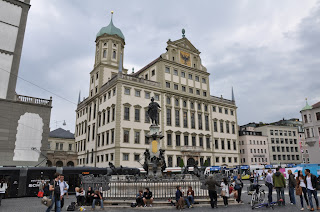It goes without saying, but it's clearly been a while since I've posted anything. What began as simple procrastination during a beautiful summer was exacerbated by a complete lack of free time and (sadly) outright laziness.
On the positive side, Emilie and I have gotten in some great trips since my last update. In late-June we visited the Normandy and Brittany regions of France. What began as a weekend trip for Emilie's cousin's wedding evolved into a week-long road-trip through Northwest France. I have always been interested in WWII history, so the highlight was definitely our visit to the D-Day beaches.
In July we headed back to the U.S. for my friend Matt's wedding. Though the trip was a bit short, it was great to see all my friends back home and get to celebrate such a special occasion with them. I also got to spend some quality time with my cousin and her daughter, who were in town during the visit. The only negative was that my parents weren't there. They were actually on a cruise in Northern Europe with their friends, so we more or less had swapped time zones for a bit.
In early August Emilie and I headed back to France so she could further expose me to "the most beautiful country in the world" (her words, not mine...though with each trip it's getting harder and harder to disagree). This time we visited two départements in Western France: Gironde (home of the Bordeaux wine region) and Dordogne (famous for its medieval castles, foie gras, truffles and prehistoric cave paintings).
September brought with it two major highlights. The first was a week-long visit from my friend Matt. We took full advantage of his time in Switzerland with some great hikes (most notably above Interlaken, where we saw the massive Aletsch Glacier) and plenty of local specialties (e.g., fondue).
The other September highlight was a two-week vacation that Emilie and I took to Japan. I could write for hours on this experience and hopefully someday will. But for now, let me just say that Japan is an unbelievably beautiful country with amazing people, food and sights. And although we packed a lot into our trip, we barely scratched the surface and I'd love to go back again someday.
I spent most of October in a political haze, obsessed with every development in the presidential election no matter how small. The only respite was a weekend trip to Paris to see Radiohead. The show was absolutely amazing and definitely one of the best concerts that I've been to.
As for November, it was fairly relaxed compared to the summer / early-Fall. The highlights were some gatherings with Emilie's family (including a fantastic post-Thanksgiving / pre-X-mas dinner) and a weekend trip to the city of Reims in the Champagne region of France. We also devoted a lot of time to our new favorite TV show: Homeland. After hearing about the show for the past year, we finally started watching it, are fully caught up, and now anxiously await each new episode.
And now here we are. Christmas is fast approaching and soon Emilie and I will be heading "home" (well, at least to what I still consider "home") for some quality time with friends and family over the holidays. Hopefully the weather is a bit warmer than in Lausanne, where this morning it snowed. But not too warm.
As for this site going forward, I need to figure out a more sustainable way to keep it updated. And one day I hope to get caught up and post some pictures / details of the highlights mentioned above. In the meantime, I think I'll probably just plan to start fresh with updates as of the new year.


















































